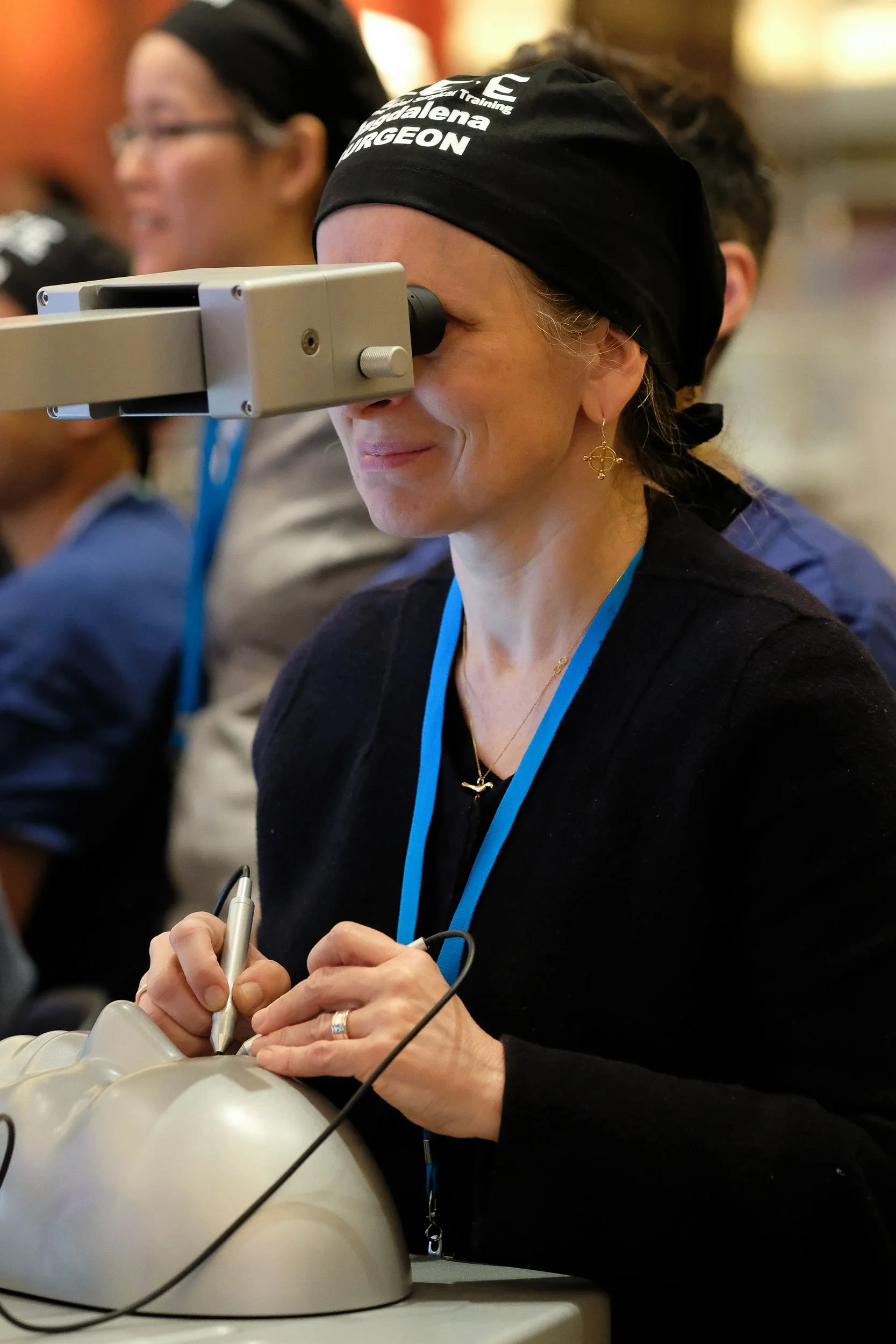To permit training of anterior segment surgery, the Eyesi® Surgical platform (VRmagic, Mannheim, Germany) is equipped with a cataract eye interface, cataract instrument set, and foot pedals (figure 1). Surgeons see the intraocular surgical field through the operating microscope. The view is in stereo and offers realistic depth of field. Focus and zoom can be altered by using the microscope foot pedal. The instrument handpieces are inserted through incisions in the model eye. The cataract patient model head can be operated on from a temporal or superior position. This platform provides surgeons with a high-fidelity simulation of the set-up, equipment, and skills required for live intra-ocular surgery.
Eyesi® Surgical has been incorporated into many training programs around the world. In 2018, Ear + Eye was pleased to join a list of elite Ophthalmic Surgical Training Facilities to offer this advanced technology. In particular, we were proud to incorporate this technology into a structured program that continued to use other well regarded wet and dry simulation models and a high standard of teaching to develop what we believe to be an inclusive, thorough means for preparation of ophthalmic trainees for live intraocular surgical training.
In 2010, an American group published a report confirming that experienced surgeons performed better at a particular task using the Eyesi simulation platform than inexperienced surgeons or than those with no experience at all.1 This “construct validity” had previously been shown for some of the other tasks available on the same simulator.2,3 These studies and others, as well as significant hardware and software improvements of the VR simulator over the last 8-10 years have led to a large body of research surrounding VR training for cataract surgery.
Certain factors, including pressures on training facilities, reduced training and teaching time, operating theatre cost and efficiency requirements, increased number and complexity of procedures, patient awareness/resistance to taking part in training, and an overall focus on reducing error and cost relating to medical care have led to increasing pressures on surgical training programs over the last few years. Virtual reality simulation is one method by which we aim to address some of these impacts at Ear + Eye. We believe this program allows our trainees to practice in a safe, ethical, repeatable, and low-pressure environment whilst increasing their skills to the level required for live surgical practice.
In 2009, Rogers et al reported that implementation of a structured surgical curriculum including VR simulation had resulted in a significant (P < 0.001, almost 50%) reduction of ophthalmic resident cataract surgery complication rates.4 Later, in 2011, another group reported similar findings, with residents training using this virtual reality platform to have shorter phaco times, lower percentage powers, fewer intraoperative complications, and a shorter learning curve. 5
VR cataract surgical training is therefore an extremely well validated tool that has been shown to improve safety and outcomes of cataract surgery performed by trainee surgeons.
At Geneye, we believe in furthering the education of all surgeons, not just trainees. We look forward to extending the benefit of VR to consultants, and to using this technology to train for the unexpected, or rarely occurring complication. Upskilling in these areas is critical, and should be performed frequently. The utility of virtual reality training for ophthalmologists is extensive. We are just scratching the surface.
Figure 1. Eyesi® Surgical platform (VRmagic, Mannheim, Germany)
References
1. Privett B, Greenlane E, Rogers G, Oetting T. Construct Validity of a Surgical Simulator as a valid model for capsulorhexis training. J Cataract Refract Surg 2010; 36:1835–1838
2. Rossi JV, Verma D, Fujii GY, Lakhanpal RR, Wu SL, Humayun MS, de Juan E Jr. Virtual vitreoretinal surgical simulator as a training tool. Retina 2004; 24:231–236.
3. Mahr MA, Hodge DO. Construct validity of anterior segment anti-tremor and forceps surgical simulator training modules; attending versus resident surgeon performance. J Cataract Refract Surg. 2008; 34:980–985.
4. Rogers G, Oetting T, Lee A, et al. Impact of a structured surgical curriculum on ophthalmic resident cataract surgery complication rates J Cataract Refract Surg 2009; 35:1956–1960
5. Belyea DA, Brown SE, Rajjoub LZ. Influence of surgical simulator training on ophthalmology resident phacoemulsification performance. J Cataract Refract Surg 2011; 37:1756–1761


